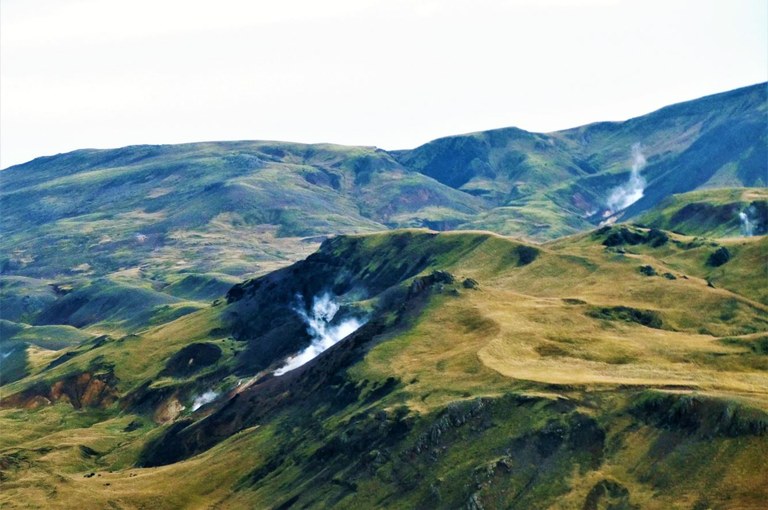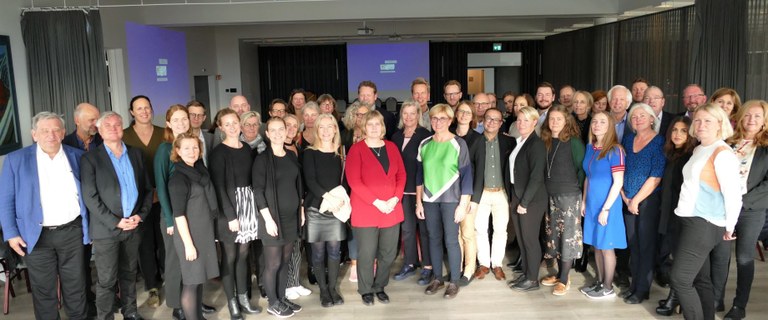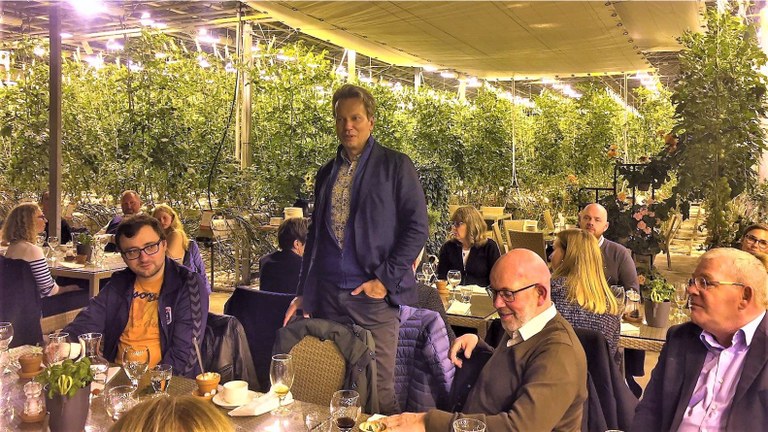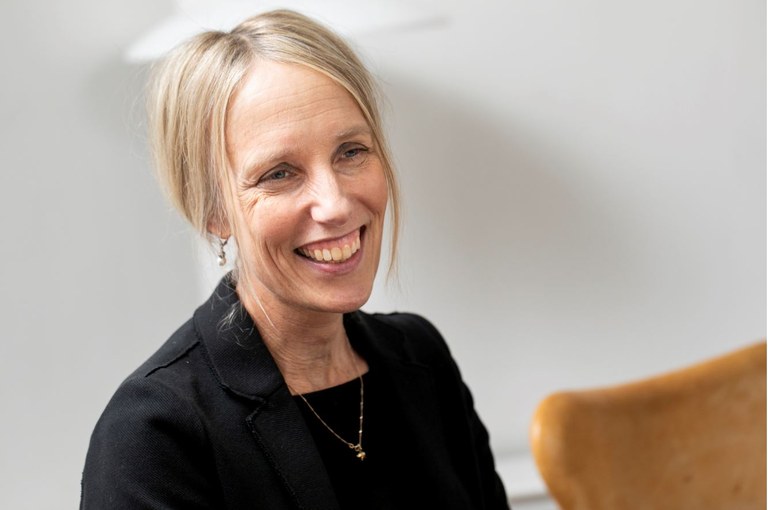The Nordics: practical and industrious cooperation
At an arrival halls café at Reykjavik airport, researchers Kristin Alsos and Jon Erik Dølvik are sat working. They are waiting for the rest of the group arriving from different Nordic countries before sharing a taxi to Hveragerði, an hour from Keflavik.
The wallpaper on a low dividing wall makes it look as if they are sat in a library. Yesterday’s well of knowledge has become a pretty backdrop. What counts today is the mobile, the laptop and the nearly finished Powerpoint presentation. The two researchers have been invited to a two-day long Nordic meeting on labour market issues.
They are going to talk about the big research programme on the future of work, headed by the Fafo research foundation and financed by the Nordic Council of Ministers. At the café, they are also exemplifying today’s working life. Any waiting time is spent logging on.
The Nordic cooperation features many abbreviations which can be confusing for those who are not familiar with it. The Nordic Council of Ministers is actually 11 permanent ministerial councils – cooperation units where government ministers who share the same portfolios meet once a year to brief each other and launch joint initiatives. A twelfth ad hoc ministerial council deals with questions of digitalisation.
Committees of senior officials, made up of civil servants from the Nordic countries, prepare and follow up on the issues addressed by the ministerial councils. On labour market issues you have MR-A, the Nordic Council of Ministers for Labour, and below that is EK-A, the Nordic Committee of Senior Officials for Labour, with eight representatives – one from each country and autonomous area.
There are also three committees where representatives for different civil services and public companies meet. The committees have names that reflect their roles: the Labour Market Committee, the Labour Law Committee and the Working Environment Committee.
All the speakers and staff from the Council of Ministers make up a small caravan of maxi taxies travelling from the airport to Hveragerði.
During the journey, the conversation is Scandinavian. The Icelandic taxi driver is addressed in English, and he provides weather and traffic updates.
As we join the ring road which runs around the whole of Iceland, we head east and drive into Suðurland, one of Iceland’s nine regions covering 22,000 square kilometres. That is twice the size of Kosovo or Lebanon, but with a population of less than one person per square kilometre. Driving through this deserted landscape we approach an active volcanic area.

Hveragerði lies on the banks of the Varmá river in what is part of the Hengill volcano. The town has 2,500 and is known for its many hot springs and fumaroles – openings in the Earth’s crust where steam escapes. The heat is used to run different greenhouses, or in hotels like Örk, where we check in, for heating a swimming pool and a sauna where the hot steam rises straight up through the benches.
Meetings are already underway in the hotel’s conference halls. When everyone has arrived, it is easy to see that a considerable number of people are involved in the Nordic cooperation on the labour market alone.
Jon Erik Dølvik, who heads the Future of Work research programme – the Nordic region’s contribution to the ILO’s centenary – underlined that the meeting was about more than researchers presenting their results.
“We can do research on what is happening in Nordic labour markets up until today, but this does not tell us that much about what will happen in the next five to ten years if we do not also know how politicians and the social partners will respond to the developments that we describe.”
After the researchers' presentations, which is attended by everyone, a group photo is taken to show how many people take part in the Nordic cooperation in the labour market area alone:

Group picture in Iceland where the Nordic Committee of Senior Officials for Labour met, along with three other committees working with labour issues.
Christina Springfeldt, Jens Oldgard, Cecilie Bekker Zober and Louise Svensson from the Council of Ministers' secretariat have prepared the meeting of the EK-A. They write a protocol and make sure everything goes to plan. The head of the Icelandic Presidency Ingi Valur Jóhannsson has experience from innumerable Nordic meetings, and speaks slowly and clearly so that everyone understands.
This is what it can look like, the official Nordic cooperation. It is about the exchange of information, debating and formulating strategic aims, going through and approving the budgets for the different areas – in this case the labour market.
Since Iceland held the Presidency in 2019, most Nordic meetings were held there that year. In 2020, Denmark takes over and many of the participants are looking forward to the fact that some of the meetings will be held in the Faroe Islands and in Greenland.
The host countries often try their best to find interesting places to host the meetings, stopping short of them becoming pure tourism.
One evening, all the participants gather for a dinner inside a large tomato greenhouse, where one of the veterans in the Nordic cooperation is bid farewell – Icelandic Permanent Secretary Gissur Pétursson.

Dan Grannas, standing, gives a speech among the tomatoes for Gissur Petúrsson, who is sat on the right
In his thank you speech, Gissur Petúrsson says working with the Nordic cooperation is the must fun you can have.
Although the programme is tight, there is also some time for some running through the rough landscape, hot water swimming or just walking for a while past the houses near the hotel to reflect on the fact that much is different in the Nordic region.
A few weeks later we talk to Christina Springfeldt about the Nordic cooperation. She heads the department for knowledge and welfare at the Council of Ministers, which also deals with working life issues.
“I have always worked with Nordic issues. Earlier I worked at the Swedish government office. Work here at the Council of Ministers does resemble that of a government office in some ways, but there is one big difference. Here in Copenhagen you’ll find a Nordic, international atmosphere, we speak our different Nordic languages.”
She has also spent time in even more cosmopolitan Brussels, where she took part in many negotiations.
“When I returned from Brussels, I often felt drained and frustrated.”
She sometimes despaired over the time it could take to reach joint decisions.
“It could go on for years, because no one was actually prepared to give up their own legislation."
 Christina Springfeldt. Photo: Tomas Bertelsen.
Christina Springfeldt. Photo: Tomas Bertelsen.
"When I came home from a Nordic meeting, however, I always felt inspired and full of energy. The Nordic meetings are efficient, and one can really learn a lot. We are very similar, yet at the same time there are also differences.
“In a Nordic setting, you also get to hear about the proposals which have failed. You share information in a completely different way. You are among friends.”
One of the reasons for the big difference between Brussels and Copenhagen is the fact that within the EU you are often dealing with giving up sovereignty, while the Nordic cooperation often focusses on the exchange of information.
“But the cooperation can also be very concrete – like the work which is now being undertaken to make it possible to use your electronic identity in another country. This is something that will make it easier for people who move to a different Nordic country.”
- Theme content
-
A Monday in the service of the Nordics
Inspired by TED Talks: Nordic podcast launch in the USA
New profile leaves Nordic traces around the world
"More hard issues should be discussed at the Nordic Council"
Iceland: Paternity leave a boost to men’s identity
The Nordics: practical and industrious cooperation
The Nordic Council of Ministers’ vision for 2030
 Follow us on Facebook
Follow us on Facebook
